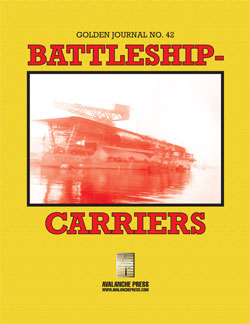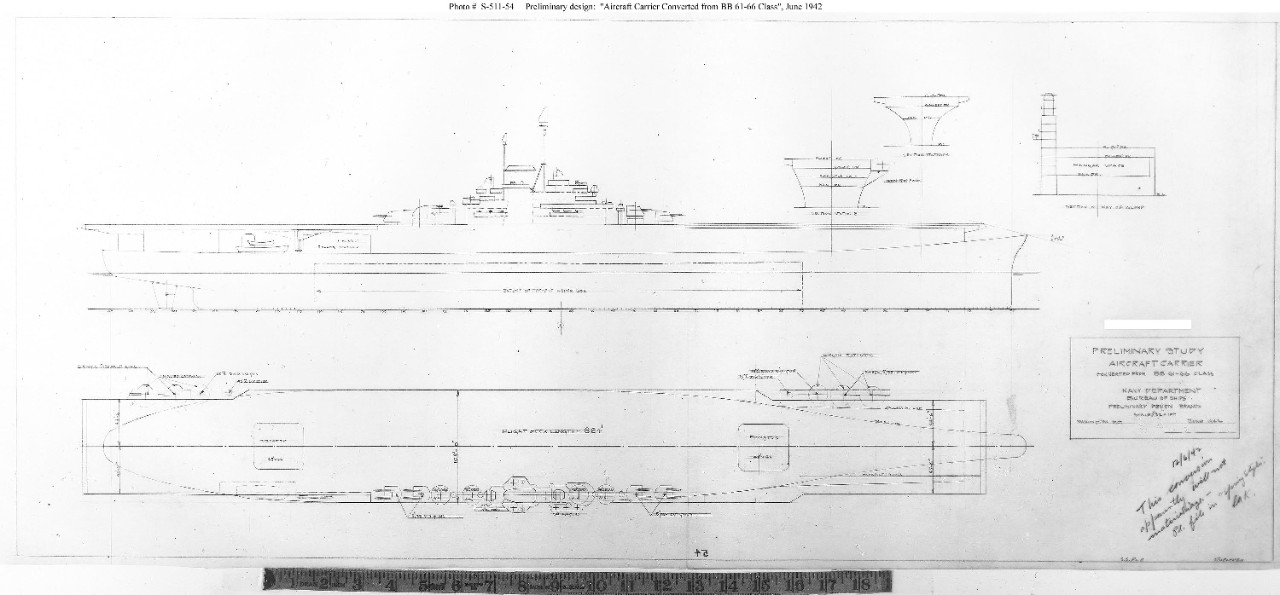| Golden Journal No. 42:
Battleship-Carriers
American Conversions
by Mike Bennighof, Ph.D.
October 2022
 In the summer of 1941, U.S. President Franklin D. Roosevelt developed an obsession. The new aircraft carrier Hornet was due to commission in October, and then the Navy would have to wait another three years before the next new carrier, Essex, joined the fleet. In the summer of 1941, U.S. President Franklin D. Roosevelt developed an obsession. The new aircraft carrier Hornet was due to commission in October, and then the Navy would have to wait another three years before the next new carrier, Essex, joined the fleet.
But at the same time, the Navy had ordered 54 Cleveland-class light cruisers (five more would be added subsequently), by far the largest class of cruisers ever built by any nation. Surely, Roosevelt, argued, some of those hulls could be spared and turned into aircraft carriers. Even if these carriers were smaller than the fleet carriers, they could be brought into service much faster than the Essex-class ships.
This turned out not to be true; with peacetime budget restrictions shattered, the new carriers began to pour out of the shipyards and Essex would actually commission before the first light carrier, Independence (the former cruiser Amsterdam). The light carriers added more decks to American carrier task forces, but the U.S. Navy did not suffer a carrier shortage and would not have been substantially less powerful with additional light cruisers in place of the light carriers.
Just about every Navy bureaucracy disliked the light carrier project; it would disrupt the shipbuilding program, it would be costly, and it would provide undersized carriers from which it would be difficult to operate the new generation of larger, more powerful carrier planes. Accident rates would climb, while the ships themselves would be vulnerable to enemy action.

The Navy’s Iowa-conversion sketch.
The Navy’s middle management successfully stalled the project for months, but the Japanese attack in December 1941 gave Roosevelt new impetus. The first light carrier conversion was authorized in January 1942, based on existing plans for small carriers that went back to the mid-1930’s. At the same time, the Bureau of Ships ordered studies of other, larger hulls that might be suitable for conversion to aircraft carriers; these had the virtue of potentially more effective air operations, but did not have pre-existing plans from which the naval architects could work – and with the pressure of wartime, the Navy did not have a surplus of architects to give over to paper fantasies.
The assessment found that the Baltimore-class heavy cruiser, four of which had been laid down in 1941, would produce a better light carrier than a Cleveland hull, but the heavy cruisers were considered far more valuable than the light cruisers and the Bureau did not want to lose any of them.

Two Iowa-class battleships had been laid down in 1940, and two more in January 1941. The Bureau of Ships produced sketches of a carrier conversion in June 1942. The re-built Iowa greatly resembled the Essex class, but with some crucial differences. Though a much larger ship than Essex (45,000 tons for the converted Iowa, 32,000 tons for Essex), she would carry fewer aircraft (70 for the converted Iowa, 88 for Essex). She would be slightly less fast (32.5 knots for the conversion, 33 knots for the purpose-built carrier) but would have substantially better protection (she would apparently retain her 12-inch belt armor).
But the disadvantages of the converted Iowa went beyond the paper figures. She would lack the deck-edge elevator of Essex and retain the fast battleship’s clipper bow, thereby raising her center of buoyancy and increasing her roll in a heavy sea. She would rest lower in the water than Essex, and would not have the hangar-deck catapult of the Essex class (which was subsequently removed anyway, but this was not foreseen at the time), and only one catapult on the flight deck (in practice, some Essex class ships also had only one, some had two, and Essex herself commissioned without any at all).
The biggest obstacle, however, was Chief of Naval Operations Ernest J. King. King wanted the fast battleships for the fleet, and would not countenance their conversion to other uses. And so, the sketch includes the note “This conversion apparently will not materialize.”

The Navy’s Alaska-conversion sketch.
Far more likely to be approved for conversion were the big Alaska-class “large cruisers,” sometimes referred to as “battle cruisers.” They would displace 30,000 tons, and share many design aspects with the Essex class carriers including the same machinery. And unlike the fast battleships, there was some doubt as to their utility in the new war; they had been intended to counter the German commerce-raiding armored cruisers which turned out to have far less impact on merchant shipping than feared before the war. They also had some value as escorts for fast carrier task forces, but the fast battleships could fill that role far more effectively.
Perhaps most importantly, all six authorized battle cruisers would be built at New York Shipbuilding’s yard in Camden, New Jersey, the same yard that had been assigned the light carrier conversions. More design thought appears to have gone into the Alaska conversion than that of the Iowa class. They would lose half of their belt armor, dropping from nine inches to 4.5 inches, but would lack the compartmentalization of the Essex design – the battle cruisers’ protection was maximized against the threat of shellfire rather than bombs and torpedoes.

Like the converted Iowa, she would lack a hangar-deck catapult and deck-edge elevator; she would operate a smaller air group than the ex-battleship, with just 63 planes (the difference coming in her shorter flight deck permitting a smaller deck park). Her cruising radius would be substantially less than Essex.
With no real role for the battle cruiser, the Alaska class would seem to have been an excellent prospect for conversion. But at the time, only one ship had been laid down, Alaska herself, and that less than a month previously. Rather than build a less-capable ship from the keep up, it would make more sense to cancel the battle cruisers outright and replace their contracts with six more Essex-class ships.
And that more or less occurred; as steel grew short, the battle cruisers lost priority compared to other projects and construction slowed. Three of the six were cancelled and never laid down. Two arrived in the Pacific during the last year of the war, where they served mostly as smaller versions of Iowa, performing the same missions of shore bombardment and carrier escort. The last ship would be launched after the war had ended, but never completed.
Golden Journal No. 42: Battleship-Carriers includes pieces for all six Iowa-class fast battleships as converted to aircraft carriers, and two of the Alaska class. Plus, you get scenarios for Second World War at Sea: Midway, so you can play with them.
The Golden Journal is only available to the Gold Club (that’s why we call it the Golden Journal). It’s $12.99, exclusively for members.
Click here to join the Gold Club.
See your Gold Club Insider newsletter for ordering information.
Sign up for our newsletter right here. Your info will never be sold or transferred; we'll just use it to update you on new games and new offers.
Mike Bennighof is president of Avalanche Press and holds a doctorate in history from Emory University. A Fulbright Scholar and NASA Journalist in Space finalist, he has published a great many books, games and articles on historical subjects; people are saying that some of them are actually good.
He lives in Birmingham, Alabama with his wife, three children, and new puppy. He misses his lizard-hunting Iron Dog, Leopold.
Want to keep Daily Content free of third-party ads? You can send us some love (and cash) through this link right here.
|
